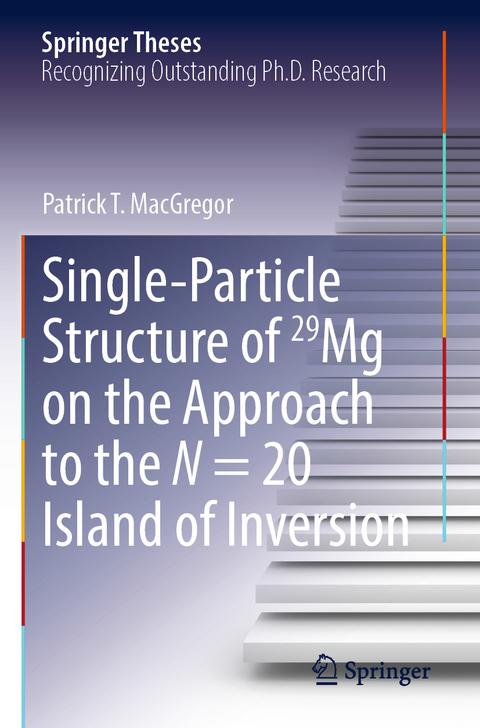
Single-Particle Structure of 29Mg on the Approach to the N = 20 Island of Inversion
Springer International Publishing (Verlag)
978-3-031-19121-3 (ISBN)
The nuclear shell model has had much success when describing nuclear structure. It is able to describe the single-particle states of nuclei, and gives understanding as to how nuclear structure evolves as the number of nucleons changes in a nucleus. This led to the discovery of the so-called magic numbers, which designate particularly stable configurations of protons and neutrons in nuclei.
With the advent of radioactive ion beams, it has become possible to probe exotic nuclei to test current theories of nuclear structure. These investigations have led to the discovery of exotic nuclear phenomena, with structures different to those found in stable nuclei. One of these is the N=20 island of inversion, where configurations that appear in stable nuclei become less bound than more exotic particle-hole configurations across a shell gap. Another is the weakening of the magic N=20 shell gap to N=16 as the number of protons is reduced in this isotonic chain.
Of particular interest are the magnesium isotopes, which exhibit a swift transition into the island of inversion with 29Mg lying outside and 31Mg lying inside. In addition, 29Mg lies one neutron outside N=16, so is also able to give insight on the weakening of the N=16 shell gap.
Mapping this region of the chart of nuclides helps in the understanding of the evolution of this nuclear structure. A useful probe for this task is single-particle transfer reactions. However, these reactions have been hindered by low yields from radioactive ion beams, as well as suffering from kinematic effects that obscure the states that need to be observed. The ISOLDE Solenoidal Spectrometer (ISS), that measures these transfer reactions in a solenoidal magnetic field, was designed to counteract these effects. With the high-yield radioactive ion beams at ISOLDE, CERN, these transfer reactions became viable.
Therefore, the nuclear structure of 29Mg was probed using the d(28Mg,p) reaction using this device. This work marks the first measurement using the ISOLDE Solenoidal spectrometer and the first time that a solenoidal spectrometer has been used at an ISOL radioactive beam facility. The measurements highlight the interplay of nucleon-nucleon interactions and the geometry of the nuclear potential in driving observed trends in single-particle structure, in particular the changes in closed shells towards doubly magic 24O
Patrick T. MacGregor is a nuclear-structure physicist, probing exotic nuclear systems primarily using transfer reactions. He completed his PhD in experimental nuclear physics at The University of Manchester in 2021, investigating the single-particle structure of the neutron-rich 29Mg, the results of which are written in this volume. This details the results from the first experiment at the ISOLDE Solenoidal Spectrometer (ISS), a novel device at the CERN facility that is able to study exotic nuclear systems. This work was published in Physical Review C 104, L051301 (2021). He is an experienced user of this device, and has supported other experimental campaigns that use it (see, for example, T. L. Tang et al., Physical Review Letters 124, 062502 (2020)).
Currently, he is pursuing postdoctoral research using transfer reactions to extract the occupancies and vacancies of the A=124 neutrinoless double beta decay system. Additionally, he is continuing his research on the magnesium isotopes by analysing data from an analagous reaction performed at the ISS to investigate the single-particle structure of 31Mg. Outside of work, he enjoys spending time with his wife, Ally, who has brought colour to his otherwise boring lifestyle.
Introduction.- The Shell Model.- Transfer Reactions and Reaction Theory.- Experimental Details for the d(28Mg,p)29Mg Reaction.- Analysis of the d(28Mg,p)29Mg Experiment.- Discussion of the d(28Mg,p)29Mg Experiment and Conclusions.- Appendix: Extracting Angles and Excitation Energy in ISS using Relativistic Kinematics.- Appendix: The Rate of Change of Centre-of-Momentum Angle with Laboratory Angle.- Appendix: Evolution of Cuts used in ISS for the d(28Mg,p)29Mg Experiment.- Appendix: Fitting Angular Distributions.- Appendix: Cross Section Data for 29Mg.
| Erscheinungsdatum | 15.12.2023 |
|---|---|
| Reihe/Serie | Springer Theses |
| Zusatzinfo | XIX, 147 p. 94 illus., 84 illus. in color. |
| Verlagsort | Cham |
| Sprache | englisch |
| Maße | 155 x 235 mm |
| Gewicht | 272 g |
| Themenwelt | Naturwissenschaften ► Physik / Astronomie ► Atom- / Kern- / Molekularphysik |
| Schlagworte | CERN • direct reactions • inverse kinematics • Isolde • ISOLDE Solenoidal Spectrometer • ISOL Facility • Magic numbers • N=20 Island of Inversion • nuclear physics • Nucleon-nucleon interactions • Shell Evolution • Single-Particle Structure • Transfer Reactions |
| ISBN-10 | 3-031-19121-8 / 3031191218 |
| ISBN-13 | 978-3-031-19121-3 / 9783031191213 |
| Zustand | Neuware |
| Haben Sie eine Frage zum Produkt? |
aus dem Bereich


